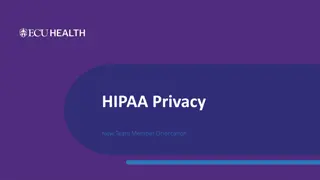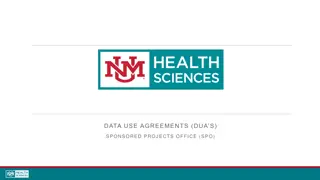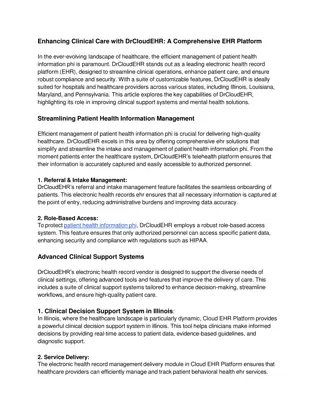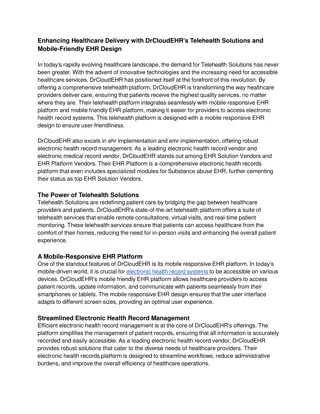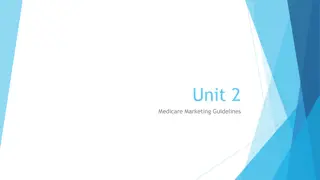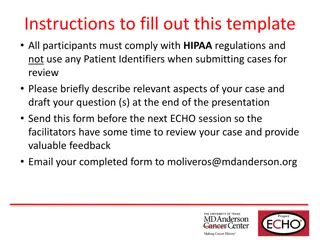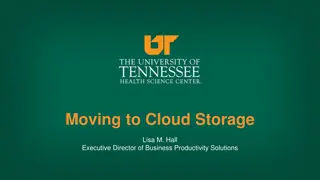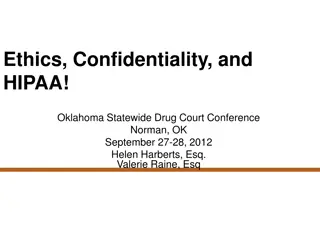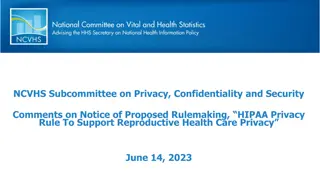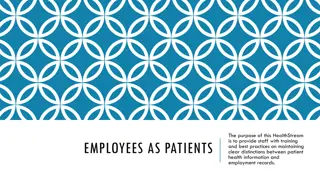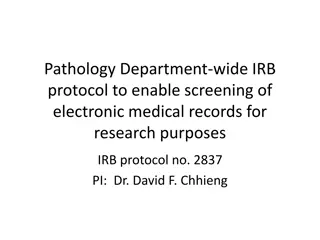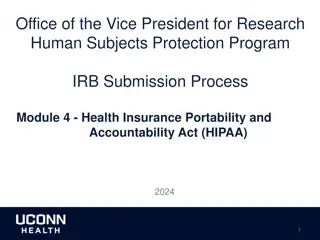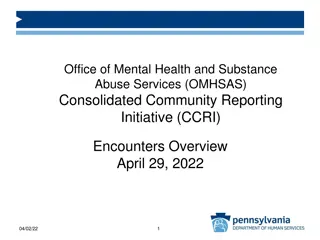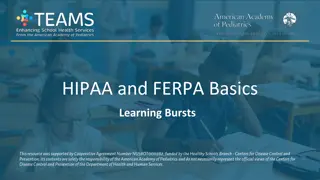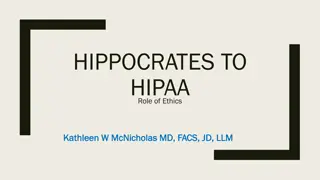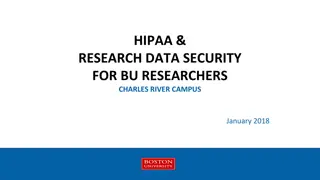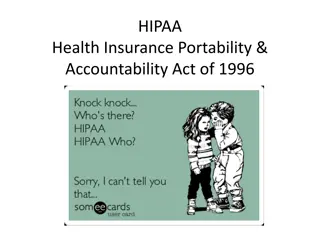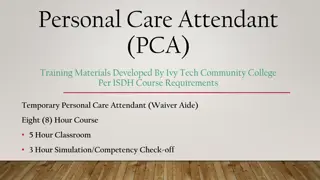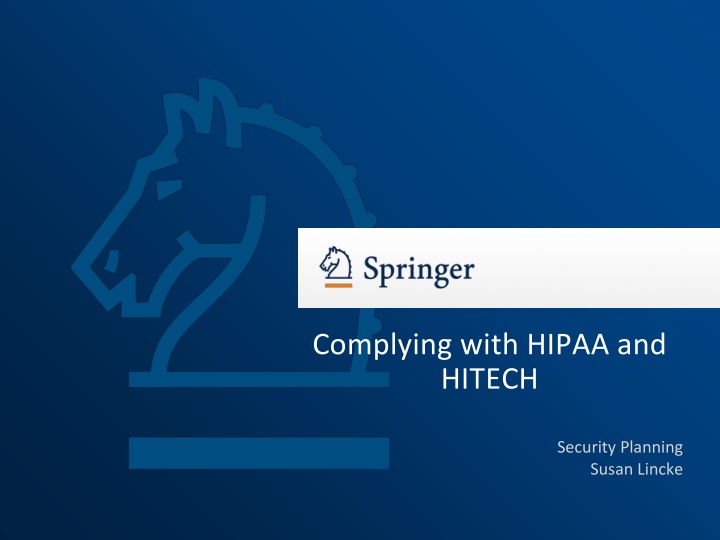
Essential HIPAA and HITECH Security Planning Insights
This educational material delves into the intricacies of HIPAA and HITECH security planning, providing a comprehensive overview of key aspects such as HIPAA introduction by Senators Edward Kennedy and Nancy Kassebaum, the different titles of HIPAA, rules and standards under Title 2, and reasons for the legislation. The content aims to equip students with a deep understanding of HIPAA, Privacy Rule, Security Rule, and related concepts to enhance their compliance knowledge and skills.
Download Presentation

Please find below an Image/Link to download the presentation.
The content on the website is provided AS IS for your information and personal use only. It may not be sold, licensed, or shared on other websites without obtaining consent from the author. If you encounter any issues during the download, it is possible that the publisher has removed the file from their server.
You are allowed to download the files provided on this website for personal or commercial use, subject to the condition that they are used lawfully. All files are the property of their respective owners.
The content on the website is provided AS IS for your information and personal use only. It may not be sold, licensed, or shared on other websites without obtaining consent from the author.
E N D
Presentation Transcript
Complying with HIPAA and HITECH Security Planning Susan Lincke
Security Planning: An Applied Approach | 3/18/2025| 2 Objectives: Students shall be able to: Define HIPAA, Privacy Rule, Security Rule, CE, PHI. Define threat, vulnerability, threat agent Describe what Privacy Rule covers at a high level Describe what Security Rule covers at a high level Describe the difference between Required and Addressable for the Security Rule.
Security Planning: An Applied Approach | 3/18/2025| 3 HIPAA Introduced by Senators Edward Kennedy & Nancy Kassebaum; passed 1996 Portability: Workers can continue health care between different employers Group insurance cannot reject, not renew, or charge higher premiums of certain individuals Simplify administration by creating a health care transaction standard Accountability: Penalties for non-compliance Tax provisions
Security Planning: An Applied Approach | 3/18/2025| 4 HIPAA Titles Title 1: Health Care Insurance Access, Portability, and Renewability Title 2: Preventing Health Care Fraud & Abuse, Administrative Simplification, Medical Liability Reform Title 3: Tax-related Health Provisions Standardizes medical savings accounts Title 4: Application and Enforcement of Group Health Insurance Requirements Title 5: Revenue Offsets Defines how employers can deduct company-owned life insurance premiums from income tax
Security Planning: An Applied Approach | 3/18/2025| 5 Title 2 Has Three Rules Transactions, Code Sets, and Identifiers: Standards for electronic transmission Electronic Data Interchange: Standardized records for health care transactions The Privacy Rule: Standard for Privacy of Individually Identifiable Health Information The Security Rule: Security Standard for electronic patient health
Security Planning: An Applied Approach | 3/18/2025| 6 Reasons for Legislation Records of patients or insurance claims made publicly available by accident Email reminder to take Prozac sent to 600 (not blind cc d) Woman fired from job after positive review but expensive illness 35% of Fortune 500 companies admitted checking medical records before hiring or promoting People avoid using insurance when they have AIDS, cancer, STD, substance abuse or mental illness
Security Planning: An Applied Approach | 3/18/2025| 7 Medical Identity Theft When a person s name and other parts of his/her medical identity are stolen for the purpose of getting medical services and goods. Problems: Medical info is for wrong person Inaccurate health records Wrong diagnosis Fatal treatments Imposter claims health care Medical Insurance Fraud Inaccurate Credit History: Bills sent elsewhere
Security Planning: An Applied Approach | 3/18/2025| 8 Medical Identity Thieves: Who can commit this crime? Computer hackers Members of organized crime rings Health care providers (doctor s, dentists, hospital employees) 2003: An employee at a cancer center stole the identity of a center patient. The identity thief was sentenced to 16 mos. In prison and ordered to pay restitution. 2006: A desk clerk at a Florida clinic stole the health info of over 1,000 patients. The clerk sold the data to another person. That person used the information to submit $2.8M in fraudulent Medicare claims to the U.S. government.
Security Planning: An Applied Approach | 3/18/2025 | 9 Business Challenges Facing the Health Care Industry Hospital computer systems contain notes from hospital employees and primary care physicians. Health Insurance Companies collect and compile patient data from different providers. Organizations MUST maintain the security of computer systems that hold health data.
Security Planning: An Applied Approach | 3/18/2025 | 10 Health Care Organization Covered Entities (CE) Health plan (e.g., HMO, PPO) Standard bills/records Standard bills/records Health care Clearinghouse Nonstandard bills/records Health Care Provider (e.g., doctor, hospital)
Security Planning: An Applied Approach | 3/18/2025 | 11 Health Care Organization Business Associates (BA) Covered Entities (CE) Works Health plan Accounting for Performs: Claims Processing Transcription Billing Data Analysis Independent organization Work involves health info Not bank or post office Health care Clearinghouse Health Care Provider
Security Planning: An Applied Approach | 3/18/2025 | 12 Business Associates (BA) Not Business Associates Must also be responsible with PHI Accreditation Janitorial Electrical Phone Vending Copy Conduit: Mail Financial Institution: Banks Accounting Mail Room Consulting Legal Department $$$ $ Actuarial Bank
Security Planning: An Applied Approach | 3/18/2025 | 13 Protected Health Information (PHI) Health Information Individually Identifiable Health Information Identifiers Name SSN city or county zip code phone or fax medical record # fingerprint Relates to Physical or Mental health or past/present/ future payment Created or maintained by CE or BA Protected Health Information (PHI) Covered by HIPAA & HITECH If YOU had AIDS, how could such identifiers Identify you?
Security Planning: An Applied Approach | 3/18/2025 | 14 Treatment, Payment & Health Care Operations (TPO) Health Care Operations Treatment Payment Provision & coordination of health care among health care providers, including referral Any activities involved in compensation for health care: billing, determining coverage or eligibility analyzing services Administrative functions related to health care: financial or legal or quality improvement, training, certification, case mgmt, business planning $
Security Planning: An Applied Approach | 3/18/2025 | 15 HIPAA Standard Transactions Health plan (e.g., HMO, PPO) Health Plan Eligibility Inquiry Certification & Authorization of Referral Health Care Claim Health Care Claim Status Request Enrollment or Disenrollment into Health Plan Health Plan Premium Payment Health Care Claim Payment Certification & Authorization of Referral Plan Sponsor (Employer) Health Care Provider (e.g., doctor, hospital)
Security Planning: An Applied Approach | 3/18/2025 | 16 Criminal Penalties for HIPAA Imprison- ment Up to one year $ Penalty Offense Wrongful disclosure of individually identifiable health information Up to $50K Up to $100K Up to 5 years committed under false pretenses Up to 10 years with intent to sell, achieve personal gain, or cause malicious harm Up to $500K Then consider bad press, state audit, state law penalties, lost claims,
Security Planning: An Applied Approach | 3/18/2025 | 17 HITECH: Health Information Technology for Economic and Clinical Health Act (2009) Breach Notification Rule: Introduced notification requirements Specifies how CE/BA should notify individuals and agencies if a breach of information occurs Patients need to be notified within 60 days (unless law enforcement investigation) Patient notification shall include description of what happened, date of the breach and its discovery type of information that was breached, steps the clients should take to protect themselves, and actions the CE is taking to investigate the breach, mitigate existing problems, and prevent new ones.
Security Planning: An Applied Approach | 3/18/2025 | 18 HITECH Act (2009) HITECH Category Each Violation Max $ Per Year CE/BA exercised reasonable diligence but did not learn about violation Violation is due to reasonable cause CE/BA demonstrated willful neglect but corrected violation $120-$30,113 $30,133 $1,205- $60,226 $120,452 $12,045-$60,226 $301,130 CE/BA demonstrated willful neglect and took no corrective action within 30 days $60,226-1.8 million $1.8 Million Penalties are prohibited if problem is corrected within 30 days and no willful neglect Penalties pay for enforcement and redress for harm caused
Security Planning: An Applied Approach | 3/18/2025 | 19 Breach Notification Laws The Oregonian, May 2006 In one of Oregon s largest security breaches, Providence Health System disclosed that a burglar stole unencrypted medical records on 365,000 patients kept on disks and tapes left overnight in an employee s van State Laws, called Breach Notification Laws require CEs to notify patients when their PHI has been breached If data is encrypted and laptop is lost, notification is not required This often applies to any industry that uses personal information, such as Social Security Numbers
Security Planning: An Applied Approach | 3/18/2025 | 20 The Genetic Information Nondiscrimination Act of 2008 Protects against some types of genetic testing discrimination: Insurance companies can t make eligibility decision based on genetic testing results. Insurance companies can t base cost of premiums on genetic testing results. Employers can t hire, fire or make job decisions based on the use genetic testing. Employers/Health Insurance Plans can not requiring genetic testing.
Security Planning: An Applied Approach | 3/18/2025 | 21 The HIPAA Privacy Rule + SHHhhh...
Security Planning: An Applied Approach | 3/18/2025 | 22 Privacy Rule: Develop Policies CE/BAs shall: Develop policies, procedures, and standards for how it will adhere to Privacy Rule. How will CE/BA: use and disclose PHI? protect patient rights? Regularly review policies and procedures Update policies when new requirements emerge Monitor that policies/procedures are consistently applied throughout the organization
Security Planning: An Applied Approach | 3/18/2025 | 23 Privacy Rule: No NonHealth Usage of PHI The National Law Journal, May 30, 1994 A banker who also served on his county s health board cross-referenced customer accounts with patient Information. He called due the mortgages of anyone suffering from cancer. Health information is not to be used for nonhealth purposes, unless an individual gives explicit permission
Security Planning: An Applied Approach | 3/18/2025 | 24 Privacy Rule: Need-to-Know Access Washington Post, March 1, 1995 The 13-year-old daughter of a hospital employee took a list of patients names and phone numbers from the hospital when visiting her mother at work. As a joke, she contacted patients and told them they were diagnosed with HIV. CE/BA Employees should have access only to what is absolutely required as part of their jobs. What individuals should have access to PHI? What categories of PHI should individuals have access to? What conditions are required for access? How will Business Associates & Trading Partners be informed and controlled?
Security Planning: An Applied Approach | 3/18/2025 | 25 Privacy Rule: Protections against Marketing Boston Globe, August 1, 2000 A patient at Brigham and Women s Hospital in Boston learned that employees had accessed her medical record more than 200 times. CE must obtain permission before sending any marketing materials, with limited exceptions
Security Planning: An Applied Approach | 3/18/2025 | 26 Privacy Rule: Establish Privacy Safeguards Required Shut or locked doors Keep voice down Clear desk policy Privacy curtains Password protection Auto screen savers Locked cabinets Paper shredders Safeguards should be REASONABLE Not Required Soundproof rooms Redesign office space Private hospital rooms (semiprivate ok) OK for doctors to talk to nurses at nurse stations
Security Planning: An Applied Approach | 3/18/2025 | 27 Privacy Rule: Employee Training & Accountability New York Times, Jan. 19, 2002 Eli Lilly and Co. inadvertently revealed over 600 patient e-mail addresses when it sent an all message to every individual registered to receive reminders about taking Prozac. Each CE organization shall name one person who is accountable for Privacy Rule compliance Each employee, volunteer, contractor shall be trained in privacy policies and procedures Full and Part-time
Security Planning: An Applied Approach | 3/18/2025 | 28 Privacy Rule: Individual Privacy Rights Patients have the right to: See or obtain copies of medical information (except for psychotherapy notes) Request correction to health record Receive a Notice of Privacy Practices Request restrictions as to who can see PHI Request specific method of contact for sake of privacy Know who has accessed PHI File a complaint if their rights have been violated Allow and withdraw authorizations for use and disclosure CE must: Respond to requests within 30 days May extend delay with notice for another 30 days Keep records of how PHI is disclosed
Security Planning: An Applied Approach | 3/18/2025 | 29 Notice of Privacy Practices Privacy Requirements: NPP must be available when asked for NPP must be displayed prominently in the office Health Plan must provide upon enrollment Health Provider must provide on first service delivery Both must request written acknowledgment of receipt of NPP After change, revised NPP must be issued to clients within 60 days Electronic Requirements (if web page): Must be displayed prominently on web page Must be emailed to customers after a change in NPP
Security Planning: An Applied Approach | 3/18/2025 | 30 Required & Permitted Disclosures Required Disclosure: Patient (or personal representative, e.g., parent, next of kin) Office of Civil Rights Enforcement: Investigates potential violations to Privacy Rule Permitted Disclosure: Minimum-Necessary PHI may be disclosed without authorization for: judicial proceedings, coroner/funeral, organ donation, approved research, military-related situations, government- provided benefits, worker s compensation, domestic violence or abuse, some law enforcement activities ID must be verified by proof of identity/badge and documentation
Security Planning: An Applied Approach | 3/18/2025 | 31 More Disclosures Routine Disclosure Disclosures that happen periodically should be addressed in policies, procedures, forms E.g.: Referral to another provider, school immunization, report communicable disease, medical transcription, births, deaths & other vital statistics Non-routine Disclosure CEs shall have reasonable criteria to review requests for non-routine PHI disclosures E.g., Research disclosures Incidental Disclosure CEs shall have reasonable safeguards E.g. Patient overhears advice given to another patient Accidental Disclosure Computer is stolen with PHI Disclosures must be tracked for six years
Security Planning: An Applied Approach | 3/18/2025 | 32 Disclosures Requiring Authorization Research project (special conditions may allow) Person outside health care system Employer However, employer may require authorization for drug test before hiring Other insurance companies Health care provider not involved in patient s health care Insurance company not paying patient s claims Lawyer Patient should get copy of authorization
Security Planning: An Applied Approach | 3/18/2025 | 33 Sample Authorization Form Disclosure Authorization Form Description of Information:_____________________________________ Patient making authorized disclosure____________________________ Person receiving information:__________________________________ Purpose of the disclosure: Authorization Expiration Date:________________ Patient Signature__________________________ Date:____________ A form to revoke authorization must be completed to terminate authorization. Must be retained by CE for 6 years
Security Planning: An Applied Approach | 3/18/2025 | 34 Implementing Minimum Necessary Minimum necessary: Just enough info to accomplish the main purpose E.g., Send prescription for glasses to optician, not medical history Data Classification Sensitivity of information Type of treatment required Questions to Answer What parts of record can each user type access? How will we constrain access to implement view?
Security Planning: An Applied Approach | 3/18/2025 | 35 Business Associate Contract (BAC) CEs must request BA to sign a BAC: BA will not disclose PHI BA is liable for damage due to disclosure or misuse BA will use safeguards to prevent misuse BA will report any security incident or violation of agreement BA will destroy or protect PHI upon termination of contract CE can terminate contract if violation occurs CE will provide BA copies of policies, procedures and materials for safeguarding Etc. BAs are equally liable as CEs, under HITECH Act
Security Planning: An Applied Approach | 3/18/2025 | 36 HITECH: Health Information Technology for Economic and Clinical Health Act (2009) BA s must follow the HIPAA Security Rule. BA s are held to the same standard as CE s. Health & Human Services (HHS) can: require BA s to comply with HIPAA. enforce penalties on noncompliant BA s.
Security Planning: An Applied Approach | 3/18/2025 | 37 Violation of HIPAA Privacy Rule: WTHR Investigation Leads to Record $2.25M HIPAA Settlement, Indianapolis, IN, 2006: Reported that CVS was throwing sensitive personal information in the trash (e.g.: unredacted pill bottles, prescription instruction sheets, pharmacy receipts with credit card information and health insurance account numbers. After this, other CVS pharmacies were investigated and it was found that they also were improperly disposing of PHI. In the settlement CVS was required to: Create an information security program to protect personal information. Requires that they get an independent audit every 2 years until 2029. Pay $2.25 million to settle claims. CVS agreed to: Implement a security plan that complies with HIPAA s Privacy Rule. Protect information during disposal. Develop employee training programs.
Security Planning: An Applied Approach | 3/18/2025 | 38 Patient Record Obfuscation: De-identification de-identified records: not considered PHI: risk of re-identification must be statistically very small can be processed for research, public health and healthcare operations; not subject to breach status Information that must be removed includes: names (individual, employer and family members), geographical information (excluding state or permissible zip code manipulation), dates, contact information, social security and other account numbers, vehicle and device IDs, IP addresses, biometric or facial images, etc.
Security Planning: An Applied Approach | 3/18/2025 | 39 Patient Record Obfuscation: Limited Data Set Re-identification method may use randomly-generated codes and code translation to re-identify a patient from a de-identified record. The algorithm cannot be guessably reversible; the mechanism to translate codes should be carefully controlled on a minimum- necessary basis. Limited data set: de-identified file with no guessable method of reversal. Advantage of limited data set: less opportunity for breach. When CE shares a limited data set with a BA, the CE must contract with the BA: the permissible uses of the limited data set limit the distribution of this data
Security Planning: An Applied Approach | 3/18/2025 | 40 The HIPAA Security Rule + Information Systems
Security Planning: An Applied Approach | 3/18/2025 | 41 Security Rule Enforces Privacy Rule on Computers Privacy Rule Security Rule With or w/o computer With computer Protect PHI Protect EPHI Minimum Necessary Authentication & Access Control Accounting of Disclosures Unique Login Credentials Authentication Track modifications to EPHI: Who did what when?
Security Planning: An Applied Approach | 3/18/2025 | 42 Security Vocabulary Asset: Diamonds Threat: Theft Vulnerability: Open door or windows Threat agent: Burglar Owner: Those accountable or who value the asset Risk: Danger to assets
Security Planning: An Applied Approach | 3/18/2025 | 43 Security Rule Assures Confidentiality
Security Planning: An Applied Approach | 3/18/2025 | 44 Security Services Authentication Access Control Data confidentiality Data integrity Data backup & recovery Nonrepudiation = Cannot say it wasn t you who sent or received data Risk Management
Security Planning: An Applied Approach | 3/18/2025 | 45 Risk Management Risk assessment Policy & Procedures Maintenance Security Program Enforcement Audit logs, vulnerability assessments, audit for procedure adherence and control effectiveness Patches are applied to software Data is available, confidential, & integrity is protected
Security Planning: An Applied Approach | 3/18/2025 | 46 Security Rule Standards Comprehensive Technology Neutral Scalable Administrative Controls Security Rule Small or Large Physical Controls Security Rule Technical Controls Look to Best Practices for Technology Answers e.g. NIST
Security Planning: An Applied Approach | 3/18/2025 | 47 Three Areas of Safeguards Administrative: Administrative policies, procedures, and actions to implement and maintain security controls to protect EPHI, including risk mgmt, access control, contingency plans, incident response. Security Physical: Protection of the physical access to terminals, laptops, servers, backup disks, memory, including viewing, access, maintenance and disposal. Rule Technical: Protection using technology tools to protect EPHI, including logs, encryption, authentication
Security Planning: An Applied Approach | 3/18/2025 | 48 Policies & Procedures Policies and Procedures MUST BE: Retained for 6 years after date of creation or last effect Available to workers responsible for them Must be updated regularly accommodating changes in environment & operations
Security Planning: An Applied Approach | 3/18/2025 | 49 Security Rule Standard This is recommended Address this in some way Implement equivalent alternative measure . If it doesn t apply, document well why not R=Required DO IT! A=Addressable We do this instead: ..
Security Planning: An Applied Approach | 3/18/2025 | 50 Administrative: Security Mgmt Process Risk Analysis: Conduct an accurate and thorough assessment of the potential risks and vulnerabilities to the CIA of EPHI held by the CE. R Risk Mgmt: Implement security measures sufficient to reduce risks and vulnerabilities to a reasonable and appropriate level to comply with the Security Rule R Sanction Policy: Apply appropriate penalties against workforce members who fail to comply with the entity s security policies and procedures R Info System Activity Review: Implement procedures to regularly review records of IS activity, such as audit logs, access reports, and security incident tracking reports R

